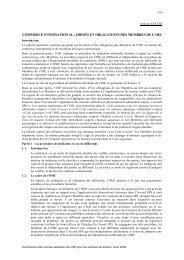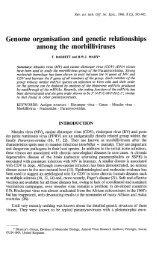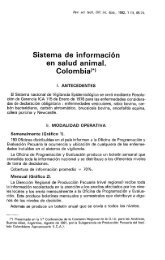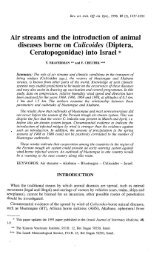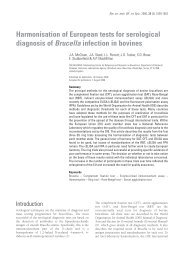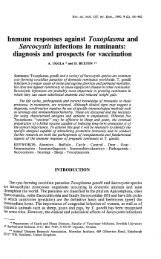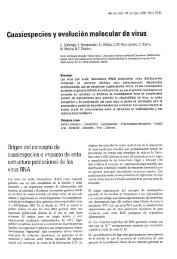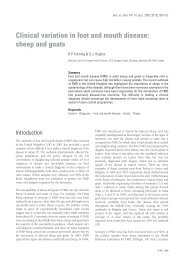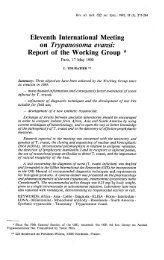26th Conference of the OIE Regional Commission for Asia
26th Conference of the OIE Regional Commission for Asia
26th Conference of the OIE Regional Commission for Asia
Create successful ePaper yourself
Turn your PDF publications into a flip-book with our unique Google optimized e-Paper software.
130. National post-vaccination monitoring in Vietnam showed that over 62% <strong>of</strong> <strong>the</strong> birds tested had<br />
protective immunity against avian influenza H5N1. Activities conducted to detect virus<br />
circulation in high-risk areas have demonstrated that H5N1 viruses are still present in <strong>the</strong><br />
country, albeit with a low prevalence, ranging from 0.15 to 2%. The number <strong>of</strong> HPAI outbreaks<br />
has decreased significantly in 2009, <strong>the</strong> overall picture being one <strong>of</strong> occasional reports <strong>of</strong><br />
sporadic outbreaks. However, <strong>the</strong> wide geographical distribution <strong>of</strong> <strong>the</strong> outbreaks suggests<br />
that <strong>the</strong> pathogen persists in several parts <strong>of</strong> <strong>the</strong> country, and <strong>the</strong> risk <strong>of</strong> disease reoccurrence<br />
<strong>the</strong>re<strong>for</strong>e remains high. Standard disease control measures such as improved detection and<br />
early response, movement control and improved biosecurity have been implemented.<br />
131. The <strong>OIE</strong> considers early detection and warning as <strong>the</strong> keys <strong>for</strong> effectively dealing with avian<br />
influenza; <strong>the</strong>y need to cover both domestic and wild species given <strong>the</strong> importance <strong>of</strong> wildlife<br />
reservoirs. This approach needs to be coupled with rapid confirmation <strong>of</strong> suspected cases and<br />
laboratory diagnosis <strong>of</strong> avian influenza. Ano<strong>the</strong>r available tool is vaccination which can be<br />
effective as an emergency measure in response to outbreaks or as a routine measure in an<br />
endemic area. Careful consideration must be given prior to implementing a vaccination policy,<br />
however, and it needs to be tailored to <strong>the</strong> epidemiological situation in <strong>the</strong> country. <strong>OIE</strong><br />
vaccination policy must include and exit strategy.<br />
Pandemic influenza A/H1N1 (2009)<br />
132. Although it is not an <strong>OIE</strong> listed disease, pandemic influenza A/H1N1 (2009) has been notified<br />
to <strong>the</strong> <strong>OIE</strong> as an emerging disease, in accordance with <strong>the</strong> notification requirements laid down<br />
in Article 1.1.3. <strong>of</strong> <strong>the</strong> Terrestrial Animal Health Code.<br />
133. Outbreaks <strong>of</strong> pandemic H1N1 (2009) influenza virus in pigs in commercial piggeries have<br />
occurred in Australia (western New South Wales, nor<strong>the</strong>rn Victoria and south-east<br />
Queensland). In all cases <strong>the</strong> clinical signs observed were mild and <strong>the</strong> pigs recovered quickly.<br />
The source <strong>of</strong> <strong>the</strong> infection was infected humans. In each case, <strong>the</strong> affected property was placed<br />
under quarantine controls, and animals were only permitted to move <strong>of</strong>f <strong>the</strong> farm once <strong>the</strong>y<br />
were healthy.<br />
134. Japan reported an outbreak <strong>of</strong> pandemic influenza H1N1 (2009) in <strong>the</strong> Osaka region in<br />
October 2009. The infection was detected through surveillance conducted in pigs without<br />
clinical signs. The outbreak was closed 21 days later when fur<strong>the</strong>r sampling returned only<br />
negative results <strong>for</strong> influenza A subtype H1.<br />
135. Chinese Taipei reported an outbreak on 19 October 2009 due to pandemic A/H1N1 (2009)<br />
influenza virus. Clinical signs were observed in pigs in <strong>the</strong> affected farm and testing <strong>of</strong><br />
samples confirmed <strong>the</strong> presence <strong>of</strong> <strong>the</strong> virus. The event is ongoing and several surrounding<br />
farms (within a 3-km radius <strong>of</strong> <strong>the</strong> index farm) are currently under surveillance.<br />
136. Indonesia in<strong>for</strong>med <strong>the</strong> <strong>OIE</strong> that samples were collected from pigs in <strong>the</strong> context <strong>of</strong> a<br />
surveillance plan. The results will be communicated to <strong>the</strong> <strong>OIE</strong> shortly.<br />
137. Reports <strong>of</strong> <strong>the</strong> occurrence <strong>of</strong> pandemic H1N1 2009 in animals are to be expected since <strong>the</strong> virus<br />
is circulating among <strong>the</strong> human population. Since <strong>the</strong> beginning <strong>of</strong> <strong>the</strong> identification <strong>of</strong> <strong>the</strong><br />
novel influenza A/H1N1 virus in humans, <strong>the</strong> <strong>OIE</strong> has encouraged all its Members to intensify<br />
<strong>the</strong>ir surveillance <strong>for</strong> potential influenza virus infections in swine or o<strong>the</strong>r influenza<br />
susceptible animals, particularly in cases <strong>the</strong>re might be some relationship between illness in<br />
animals and illness in humans. The three reports submitted by Australia, Japan and Chinese<br />
Taipei in <strong>the</strong> region, indicate that <strong>the</strong> <strong>OIE</strong>’s recommendations are being followed and show <strong>the</strong><br />
transparency <strong>of</strong> <strong>the</strong> affected Members in this situation.<br />
21





